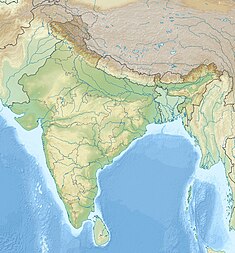Ghatotkacha Caves
| Ghatotkacha Caves | |
|---|---|
 Ghatotkacha Cave | |
| Coordinates | 20°33′09″N 75°35′06″E / 20.552620°N 75.584977°E |
| Governing body | Archeological Survey of India |
| Pilgrimage to |
| Buddha's Holy Sites |
|---|
 |
The Ghatotkach Caves are located 18 km to the west of Ajantha, near Jinjala, India.[1] The caves include three Buddhist caves, one is a chaitya and two are viharas. The caves were excavated in the 6th century AD, and were influenced by Mahayana Buddhism.[1]
The caves have an inscription by Varahadeva, a minister of the Vakataka dynasty under King Harishena (r. c. 475 – c. 500 CE).[2] Varahadeva is also known for a decatory inscription in Cave 16 at Ajanta caves in which he affirms his devotion to the Buddhist faith: "regarding the sacred law as his only companion, (he was) extremely devoted to the Buddha, the teacher of the world".[2]
The inscription at Ghatotkacha Cave is about the Buddha, the Dhamma and the Sangha.[1] At the same time, Varahadeva proudly affirms his Hindu heritage.[2] The inscription gives a long genealogy of the donor's family. It includes mention of a person named Soma, who had Kshatriya as well as Brahmana wives.[3]
The Maharashtra Tourism Development Corporation advises that the caves are only for the adventurous traveller as access is difficult.[4]
External links
[edit]References
[edit]- ^ a b c Ahir, D. C. (2003). Buddhist sites and shrines in India : history, art, and architecture (1. ed.). Delhi: Sri Satguru Publ. pp. 191–192. ISBN 8170307740.
- ^ a b c Spink, Walter (2006). Ajanta: History and Development, Volume 5 Cave by Cave. BRILL. p. 180. ISBN 9789047411871.
- ^ Singh, Upinder (2009). History of Ancient and Early Medieval India; From the Stone Age to the 12th Century. Pearson Education.
- ^ Vision Tourism 2020 – Aurangabad District Perspective Draft Plan (PDF). Aurangabad: Maharashtra Tourism Development Corporation. November 2010. Retrieved 28 June 2013.[permanent dead link]




